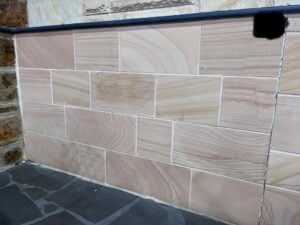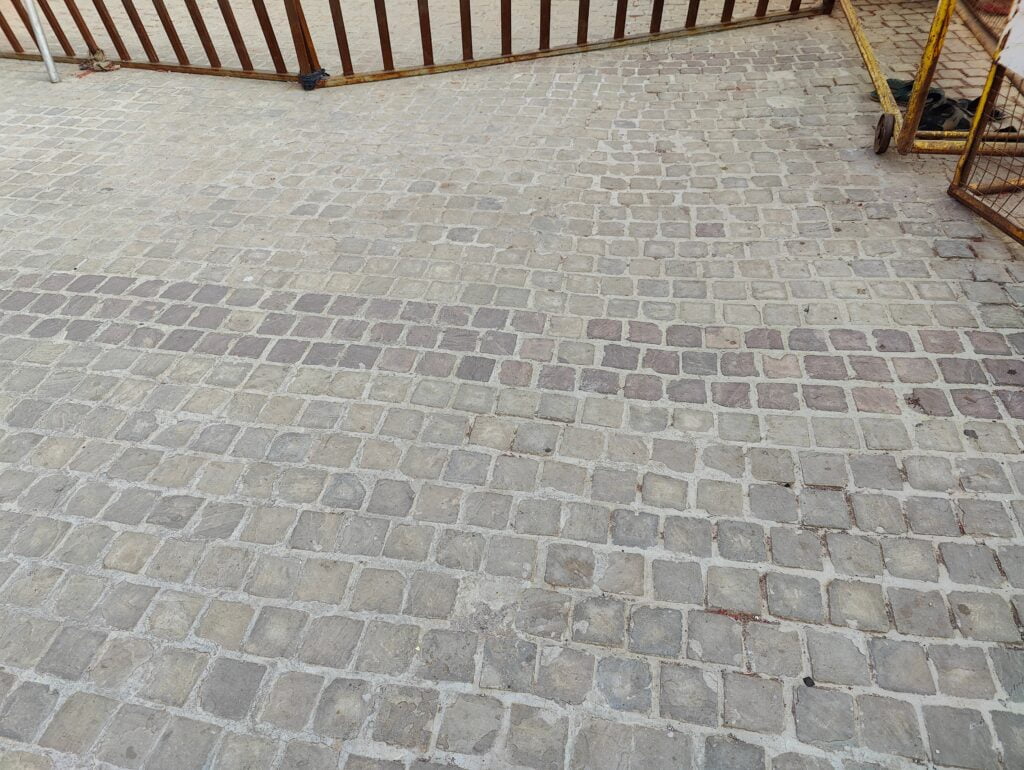There are several alternatives to Kota stone, each with its own set of characteristics, advantages, and disadvantages. Here are a few:
- Granite: Known for its durability and resistance to scratches, granite is a hard stone that can withstand high traffic areas. It comes in a variety of colors and patterns and is resistant to stains when sealed properly. However, it’s more expensive than Kota stone.
- Marble: While we’ve already discussed marble, it’s worth mentioning again as a viable alternative to Kota stone. Marble offers a luxurious and elegant appeal with unique veining patterns. It’s less resistant to wear and tear than Kota stone, but its classic aesthetic appeal is hard to match.
- Vitrified Tiles: These are ceramic tiles with very low porosity. They can be a cost-effective alternative to Kota stone and are available in various designs and patterns. They’re easy to clean and maintain, but they don’t have the same natural look and feel as stone.
- Slate: This is a fine-grained metamorphic rock that comes in a wide variety of colors. Slate is durable, resistant to stains, and has a slightly rough surface that can provide a good grip, making it a good choice for outdoor areas.
- Concrete: For outdoor spaces, concrete can be an economical and practical alternative to Kota stone. It’s strong and durable, and modern concrete can be textured and stained to look quite attractive.
- Terrazzo: This is a composite material made from chips of marble, quartz, granite, glass, and other suitable material. It’s poured in place or precast, offering a unique and colorful aesthetic. Terrazzo is durable and easy to clean, making it a good alternative for flooring.
Remember, the best alternative to Kota stone will depend on a number of factors, including the desired aesthetic, the purpose of the space, the climate, and your budget.
What is the alternative to Kota stone?
Kota stone, primarily used in building construction, is known for its hardness, durability, and cost-effectiveness. However, some people may prefer alternatives due to color variety, finish, or other aesthetic concerns. Here are a few common alternatives to Kota stone:
Tandur stone : tandur stone is one of the most durable and attractive alternatives. It comes in a wide range of colors and finishes, which makes it ideal for both indoor and outdoor applications. However, it’s generally more cheap than Kota stone.
Nimbahera Stone : For those who want an upgrade in aesthetics, it can be a great alternative. It’s prized for its luxurious appearance and variety of colors, this is a sophisticated and elegant choice that’s available in a variety of colors. It has a unique appeal due to its veining and is often used in high-end projects.
Concrete: For a more modern and industrial aesthetic, polished or textured concrete can be an excellent choice. It’s robust, flexible in terms of design possibilities, and often more cost-effective than natural stone.
Sandstone: Known for its unique grainy texture and look, sandstone can be a great alternative. It’s especially suited for outdoor installations, such as garden paths or patios.
Limestone: This is another viable alternative to Kota stone, and it’s especially good for outdoor usage due to its durability and natural aesthetic appeal.
What is the alternative to kota stone for kitchen
Kota stone, known for its durability and smooth finish, is often used in flooring and wall cladding, including in kitchens. However, if you’re looking for alternatives, there are numerous options with different properties and aesthetic appeal. Here are a few examples:
Granite: This is one of the most durable and aesthetically appealing options for kitchen countertops and floors. It’s resistant to heat, scratches, and stains.
Marble: Marble provides an elegant look and is great for baking and making pastries due to its cool temperature. However, it requires regular sealing as it is somewhat porous and can stain.
Quartz: A man-made material that is extremely durable and requires less maintenance compared to natural stones. It’s available in a wide variety of colors and patterns.
Porcelain tiles: Porcelain tiles are durable, resistant to stains, water, and heat, making them ideal for a kitchen. They’re available in many different colors and styles, allowing for a wide range of design possibilities.
Slate: Slate is a good alternative for a unique, rustic look. It is durable, non-porous, and can resist heat and scratches.
Ceramic tiles: They are affordable, come in numerous designs and colors, and are easy to clean and maintain.
Concrete: If you want a more modern, industrial look, concrete is an option. It can be stained, textured, or polished for different looks, and is very durable.
Wood or Butcher Block: Wood offers a warm, inviting look but requires more maintenance than some other materials. It’s ideal for food preparation areas and can be sanded and refinished if it gets scratched or worn.
Stainless Steel: Commonly used in professional kitchens due to its heat resistance and durability. It gives a sleek, modern look but can show scratches and fingerprints.
Glass: A modern and sleek choice that’s easy to clean and can resist heat and stains. However, it may be prone to scratching.
It’s important to choose the material based on your usage, maintenance preference, and budget. All materials have their own advantages and disadvantages, so it’s important to understand these before making a decision.
What is the alternative to kota stone to bathroom ?
If you are seeking alternatives to Kota stone for bathroom surfaces, there are several options to consider. Each material has its own unique advantages and aesthetic appeal:
Ceramic Tiles: These are an economical choice and they come in a variety of colors, shapes, and designs. They are easy to maintain and clean.
Porcelain Tiles: More durable than ceramic, porcelain tiles are water, stain, and wear-resistant. They can mimic natural stones, wood, and even concrete, providing numerous design possibilities.
Marble: This is a luxurious option, and it gives an elegant and timeless appeal to the bathroom. However, marble requires regular sealing as it’s more porous and can stain easily.
Granite: Granite tiles are very durable and have a unique, natural look. They are less likely to scratch or chip compared to other materials.
Glass Tiles: These provide a modern, stylish look. Glass tiles are resistant to stains, mold, and mildew, and are easy to clean. However, they may be more slippery when wet compared to other materials.
Slate: Slate tiles have a natural, rustic look. They are slip-resistant and durable, making them suitable for bathrooms.
Quartz: Engineered quartz has the look of stone but is more durable and requires less maintenance. It’s non-porous and resists staining better than granite, marble, and concrete.
Travertine: This natural stone has a rustic, textured, and elegant look. It’s more porous than other stones and needs to be sealed properly.
Vinyl Tiles: These are cost-effective, waterproof, and comfortable underfoot. Vinyl tiles can be made to mimic the look of many other materials, such as wood, stone, or ceramic.
Pebble Tiles: These are ideal for shower floors due to their natural slip resistance. They give a spa-like feel to the bathroom.
Remember, your choice of bathroom flooring should take into account aesthetics, durability, slip-resistance, and the ability to withstand high humidity levels.
What is the alternative to kota stone flooring?
There are several alternatives to Kota stone for flooring, each with its own unique characteristics and aesthetics. Here are some of them:
Granite: Granite is a very hard stone and it’s extremely durable. It can resist most abrasion, bear significant weight, and resist weathering. It’s ideal for high traffic areas.
Marble: This is an elegant and timeless choice for flooring. It’s available in a range of colors and is appreciated for its fine veining and rich look.
Porcelain Tiles: Porcelain tiles are highly durable, long-lasting, and available in a variety of colors, textures, and designs. They can mimic the look of natural stone and require less maintenance.
Ceramic Tiles: These tiles are cost-effective and offer a wide range of colors and designs. Ceramic tiles are easy to maintain but are less durable than porcelain tiles.
Travertine: This is a type of limestone that comes in different natural colors like tan, cream, and rusty. It gives a unique and different look with its rich and distinguished texture.
Slate Tiles: Slate is a fine-grained, foliated, homogeneous metamorphic rock derived from shale-type sedimentary rock composed of clay or volcanic ash. Slate tiles give a natural and unique look to your floors.
Vinyl Flooring: This is a synthetic cousin of linoleum that is water and stain-resistant, versatile, and provides good durability for the cost.
Wooden Flooring: A classic choice that offers a warm, beautiful look. There are various types of wooden flooring options like hardwood, engineered wood, laminate wood, and bamboo flooring.
Concrete Flooring: Polished concrete flooring is becoming more popular for its durability and sleek, modern look. It can be stained or dyed to provide different colors and patterns.
Laminate Flooring: A more affordable alternative to natural stone or hardwood, laminate flooring is easy to install and clean, though it doesn’t have the same longevity or aesthetic appeal.
Remember to choose your flooring based on the specific requirements of the area (such as moisture levels), durability, maintenance requirements, and aesthetic preferences.


